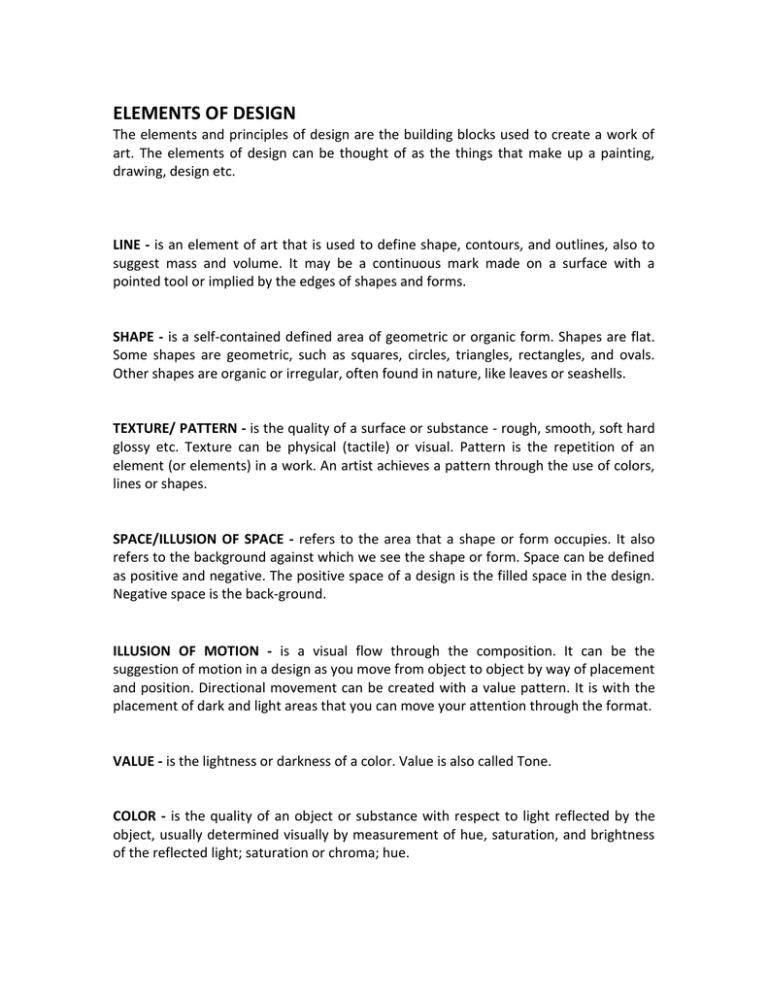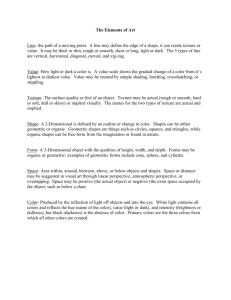PRINCIPLES OF DESIGN.doc
advertisement

ELEMENTS OF DESIGN The elements and principles of design are the building blocks used to create a work of art. The elements of design can be thought of as the things that make up a painting, drawing, design etc. LINE - is an element of art that is used to define shape, contours, and outlines, also to suggest mass and volume. It may be a continuous mark made on a surface with a pointed tool or implied by the edges of shapes and forms. SHAPE - is a self-contained defined area of geometric or organic form. Shapes are flat. Some shapes are geometric, such as squares, circles, triangles, rectangles, and ovals. Other shapes are organic or irregular, often found in nature, like leaves or seashells. TEXTURE/ PATTERN - is the quality of a surface or substance - rough, smooth, soft hard glossy etc. Texture can be physical (tactile) or visual. Pattern is the repetition of an element (or elements) in a work. An artist achieves a pattern through the use of colors, lines or shapes. SPACE/ILLUSION OF SPACE - refers to the area that a shape or form occupies. It also refers to the background against which we see the shape or form. Space can be defined as positive and negative. The positive space of a design is the filled space in the design. Negative space is the back-ground. ILLUSION OF MOTION - is a visual flow through the composition. It can be the suggestion of motion in a design as you move from object to object by way of placement and position. Directional movement can be created with a value pattern. It is with the placement of dark and light areas that you can move your attention through the format. VALUE - is the lightness or darkness of a color. Value is also called Tone. COLOR - is the quality of an object or substance with respect to light reflected by the object, usually determined visually by measurement of hue, saturation, and brightness of the reflected light; saturation or chroma; hue. PRINCIPLES OF DESIGN The principles of design are the recipe for a good work of art. The principles combine the elements to create an aesthetic placement of things that will produce a good design. How we apply the principles of design determines how successful we are in creating a work of art. UNITY - is a relation of all the parts or elements of a work constituting a harmonious whole and producing a single general effect. If you were using wavy lines and organic shapes in your composition you would stay with those types of lines and not put in just one geometric shape. EMPHASIS AND FOCAL POINT - is an area that first attracts attention in a composition. This area is more important when compared to the other objects or elements in a composition. This can be by contrast of values, more colors and placement in the format. SCALE AND PROPORTION - Are related terms, referring to size. Scale is essentially another word for size. Proportion refers to relative size – size measured against other elements or against some mental norm or standard. BALANCE - is a feeling of visual equality in shape, form, value, color, etc. Balance can be symmetrical or evenly balanced or asymmetrical and un-evenly balanced. Objects, values, colors, textures, shapes, forms, etc., can be used in creating a balance in a composition. RHYTHM - is a movement in which some elements reoccur regularly. Like a dance it will have a flow of objects that will seem to be like the beat of music.




